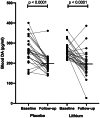Blood and cerebrospinal fluid biomarker changes in patients with HIV-associated neurocognitive impairment treated with lithium: analysis from a randomised placebo-controlled trial
- PMID: 36790601
- PMCID: PMC10185609
- DOI: 10.1007/s13365-023-01116-4
Blood and cerebrospinal fluid biomarker changes in patients with HIV-associated neurocognitive impairment treated with lithium: analysis from a randomised placebo-controlled trial
Abstract
HIV-associated neurocognitive disorders (HAND) persist in the era of antiretroviral therapy (ART). Thus, ART does not completely halt or reverse the pathological processes behind HAND. Adjuvant mitigating treatments are, therefore, prudent. Lithium treatment is known to promote neuronal brain-derived neurotrophic factors (BDNF). Lithium is also an inhibitor of glycogen synthase kinase-3 beta (GSK-3-β). We analyzed biomarkers obtained from participants in a randomized placebo-controlled trial of lithium in ART-treated individuals with moderate or severe HAND. We assayed markers at baseline and 24 weeks across several pathways hypothesized to be affected by HIV, inflammation, or degeneration. Investigated biomarkers included dopamine, BDNF, neurofilament light chain, and CD8 + lymphocyte activation (CD38 + HLADR +). Alzheimer's Disease (AD) biomarkers included soluble amyloid precursor protein alpha and beta (sAPPα/β), Aβ38, 40, 42, and ten other biomarkers validated as predictors of mild cognitive impairment and progression in previous studies. These include apolipoprotein C3, pre-albumin, α1-acid glycoprotein, α1-antitrypsin, PEDF, CC4, ICAM-1, RANTES, clusterin, and cystatin c. We recruited 61 participants (placebo = 31; lithium = 30). The age baseline mean was 40 (± 8.35) years and the median CD4 + T-cell count was 498 (IQR: 389-651) cells/μL. Biomarker concentrations between groups did not differ at baseline. However, both groups' blood dopamine levels decreased significantly after 24 weeks (adj. p < 002). No other marker was significantly different between groups, and we concluded that lithium did not confer neuroprotection following 24 weeks of treatment. However, the study was limited in duration and sample size.
Keywords: Biomarkers; HAND; HIV; Lithium.
© 2023. The Author(s).
Conflict of interest statement
HZ has served at scientific advisory boards and/or as a consultant for Abbvie, Alector, ALZPath, Annexon, Apellis, Artery Therapeutics, AZTherapies, CogRx, Denali, Eisai, Nervgen, Novo Nordisk, Pinteon Therapeutics, Red Abbey Labs, reMYND, Passage Bio, Roche, Samumed, Siemens Healthineers, Triplet Therapeutics, and Wave, has given lectures in symposia sponsored by Cellectricon, Fujirebio, Alzecure, Biogen, and Roche, and is a co-founder of Brain Biomarker Solutions in Gothenburg AB (BBS), which is a part of the GU Ventures Incubator Program (outside submitted work).
Figures

References
-
- Anderson AM, Easley KA, Kasher N, Franklin D, Heaton RK, Zetterberg H, Blennow K, Gisslen M and Letendre SL (2018) Neurofilament light chain in blood is negatively associated with neuropsychological performance in HIV-infected adults and declines with initiation of antiretroviral therapy. J Neurovirol 24(6):695–701. 10.1007/s13365-018-0664-y - PMC - PubMed
Publication types
MeSH terms
Substances
LinkOut - more resources
Full Text Sources
Medical
Research Materials
Miscellaneous

